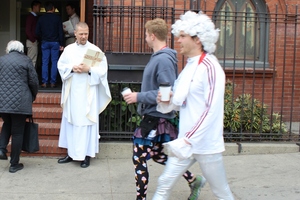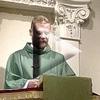A sermon responding to Elizabeth Eaton's statement on the creeds, on where the creeds stand in relation to modern society and the power of clouds.
The text notes I preached from are after the sermon audio for convenience, however, I suggest you listen to the sermon audio, because there were numerous changes during the delivery. It is in the delivery of a sermon in the midst of the people of God which is where he Holy Spirit is doing the strongest work within me; and there will not only be some changes to the notes but also emphasis and intonations that don't occur in the notes.
Sermon delivered at St. Francis Lutheran Church of San Francisco
May 17, 2015 - Ascension Sunday
"Creeds and Clouds" - Lectionary text from Acts 1:1-11 & Luke 24:44-53
Greetings my sisters and brothers, saints and sinners, children of God.
Jesus is risen. Alleluia. And then Jesus is gone. Alleluia? But he told his disciples right before the cloud took him up and away from them that he would be back, and in the meantime the spirit would be sent to them and they would be able to do amazing things. What must it had seemed to someone to have traveled with him, watched him resurrected and their hope renewed only to see him depart from them again, taken up whole into heaven.
It is this gift that Luke gives us with the Ascension into heaven, that is found in no other Gospel, except some endings of Mark, and Luke provides it to us twice, both at the end of his Gospel and at the very beginning of the marvelous sequel to Luke, the Acts of the Apostles.
 Pastor in front of St. Francis Lutheran Church on Church Street as Bay to Breakers Participants pass by. © Michael Bass-Deschenes
Pastor in front of St. Francis Lutheran Church on Church Street as Bay to Breakers Participants pass by. © Michael Bass-Deschenes How curious it is today that we read the earlier account at the end of Luke, but not until after we've already read the later account at the beginning of Acts. And as Luke lays for the account, in his Gospel as well as in Acts, Jesus, after he has returned from battling the devil and the power of death, over forty days appears to the remaining apostles and speaks to them of things they must do. That they should be in Jerusalem and be his witnesses, and that the Holy Spirit would come to them.
The apostles witness as a cloud takes him up and enfolds upon him and they watch him as he vanishes from their eyes. As we call it and celebrate it today, this is Jesus' ascension. Into heaven where he would sit at God's right hand, and rule over the apostles and the children of God and all of the earth, from then until the end of days.
The symbolism of a cloud was not lost on the Jews of Jesus' time, as they understood the Lord God traveled with Moses and the nation of Israel out of Egypt in a great spinning column of clouds by day. And while Luke's early readers may have heard literal implications of the physical act of ascension, the raising up of a cloud into the skies, where they believed heaven was located, we, of course, have a different idea of that concept.
We have Martin Luther to thank for the concept that being at God's right hand literally means being everywhere, and that Jesus rules from everywhere, and is physically present to all of God's people at the communion. But to those who were left behind, the age of Jesus' appearances as a walking, talking human being had come to an end. And what we have left is the witness of the cloud of believers over the last millennia, as set forth in the scripture and as laid out in our creeds.
The Creeds that we profess at some of our worship services which state in no uncertain terms, "he ascended into heaven, and is seated at the right hand of God," have recently come under some attention in the body of the ELCA with presiding bishop Elizabeth Eaton's statement in the recent edition of the Lutheran magazine. Bishop Eaton is writing about the wonders about how we do our worship, commonalities that are found throughout Lutherandom and about the positive aspects of consistent worship, and then speaks on the creeds with the words, "And please, please do not rewrite the creeds. It took the church a couple of centuries to come up with the Nicene Creed. Why do we think we can do better knocking it out on our laptop?"
In truth, prevailing thought in many places is that Christians run the risk of alienating new visitors who come attend worship when we recite the words of our creed, the lengthy statements of faith, because they may seem rote that the professions that we name when we recite our credo of faith seems something archaic out of a different place and time, written to end the heresies that were the height of controversy that had divided Christendom for decades during the 3rd and 4th centuries. And saying that they've lasted for centuries may be underscoring the fact that they feel outdated in their statements, that in order to be professing Christians we need not necessarily subscribe to each and every step along the way as long as we understand that God loves us and that to fulfill the commandment of our Lord and savior means to love God with all of our being and to love each other as God loves us.
But I challenge you today, my sisters and brothers in Christ that when we profess the creed of our faith we not only profess the underlying tenets of faith that unify us with the church catholic, that Christendom is more than just a personal relationship with a God that strives for us to be sanctified and to do the right thing, but that each and every statement of faith underscores our relationship with that God and our understanding of that God and how we live in fellowship and communion in the light of his he love for us.
We believe that there is one God because we believe in the power of his unmitigated love as Creator of all things, seen and unseen. We believe that God came to earth and became fully human, for his beloved creation, and that he was conceived by means of the Holy Spirit and born of a virgin, because of that love for us, in order that he be among us in the flesh, that we may believe in God and that we may be drawn to God.
And we believe that this same son was crucified for our sins, that he died that we may live and that he rose again and appeared to those who followed him. And we also believe that Christ ascended into heaven so that he may rule over the earth. And while scholars may debate the historicity of these events, seeking new ways to rediscover a historical Jesus who, outside of scripture, canon and apocryphal collections, cannot be found, that men and women of learning have demonstrated that some things described cannot possibly exist because physical laws dictate their impossibility, we also understand that the life and times of Jesus that we read in scripture are filled with miracles, which are, by definition beyond the realm of possibility, and we, people of faith who are gifted that faith by the power of his grace, and understand that miracles are a very real thing. Many of us have encountered miracles in our very own lives that brought us here. The truth in what our creeds describes help us explain how our relationship with God and each other and the past and the future matters, regardless of whether or not the impossibilities of our faith may make people take pause.
But we who worship a man who died on a cross, the most humiliating of deaths, and this impossible and ridiculous faith has sustained billions of people over centuries with very little change in meaning. And so whether or not we understand the passages of Isaiah to be reflective of the time of Isaiah, we also understand that the son of God was sent in the context of those prophecies. And if we believe in the miracle of our Lord and Savior rising from the grave three days after death, what is so unimaginable that our God, who is all-powerful, chose to use metaphorical images when the disciples watched Jesus enfolded into the mistiness of a cloud and surrounded and taken up where they could no longer see and touch and hear them in a physical sense. That God chose to use symbols to mark the passage of events that they might understand them, that we might understand them and that we all might believe.
And so, while we read the passage from Acts first, because the passage underscores the new beginning of the reign of Christ that we celebrate in celebrating his ascension into heaven, we also can look at the out-the-order narration of our readings as somewhat appropriate, because the account of the ascension into heaven, the conclusion of the Gospel of Luke, as a cliffhanger, something that is both the end of a era and the begnning of a new one. We are, today, at the end of the easter season. Jesus has risen from the dead and now Jesus has ascended into heaven. The time of Jesus strident focus on earthly activities is concluded, and Easter is ending.
Soon we look forward to the present age of man where Christ rules from where he has ascended...heaven and the time that the Holy Spirit is the primary actor in the world. It is time for a new age. It is time for Pentecost.
And filled with the power of the holy spirit, my sisters and brothers, that is some very good news. Amen.


